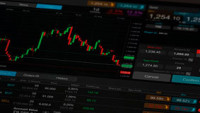 Health concerns were doing the rounds yesterday and European equity markets lost a little ground.
Health concerns were doing the rounds yesterday and European equity markets lost a little ground.
Recently there have been fears that the reopening of economies has brought about a rise in new Covid-19 cases, and that theme has dominated the past week. It was reported the lockdown conditions in Beijing are getting worse. In addition to that, US states such as Arizona, Florida and Texas registered a rise in the number of new cases. Even though it appears the health crisis is a bigger issue in the US than it is in Europe, the S&P 500 finished the session essentially unchanged on the day.
Democrats in the House of Representatives unveiled a $1.5 trillion infrastructure bill last night. The policymakers are advocating for major investment in road, rail and broadband. It is understood that a number of Republicans are concerned about the increase to debt levels it would cause. The story is likely to linger for some time so traders will keep an eye on the situation.
Equity markets in Asia are largely showing small gains. Overnight, a Chinese health official claimed the recent resurgence in coronavirus cases in Beijing is under control. Stocks in Australia pushed higher on the back of the 16.3% surge in retail sales in May. The record reading was a big rebound from the 17.7% fall posted in April. European indices are expected to open broadly unchanged.
Yesterday, the Bank of England (BoE) left rates on hold at the historic low of 0.1% in line with economists’ forecasts. The BoE increased the quantitative easing scheme by £100 billion, taking the asset purchase facility to £745 billion, meeting market expectations. In March, the central bank launched £200 billion worth of QE, so in advance of yesterday’s meeting, some dealers felt that another £200 billion or perhaps £150 billion could have been on the cards, so some were left disappointed. The decision to add £100 billion wasn’t unanimous, as Andy Haldane didn’t support the move as he felt the rebound in the demand and output was happening sooner than expected.
The BoE believe the contraction in output in the second quarter won’t be as painful as originally predicted, and that ties in with the comment that the asset purchase facility will be carried out at a slower pace. Andrew Bailey, the governor of the BoE, said the possibility of negative rates was not discussed, but he wouldn’t rule out that option. Given the expansion rate of the asset purchase facility has dropped off in June in comparison with March, and the bank believes the second quarter GDP decline won’t be as severe as initially thought, the chance of rates turning negative seems low.
Even though the update from the BoE wasn’t as dovish as some people were hoping, the pound took a sizeable knock yesterday. Recently the US dollar has acted as a risk-off play, and conversely sterling attracted funds when dealers were in risk-on mode. It would appear that a mixture of more QE and risk-off sentiment put the pound under the cosh.
The US Philly Fed manufacturing reading swung from -43.1 in May to 27.5 in June, its highest reading since February. Earlier in the week, the New York Fed manufacturing report for June came in at -0.2, which was a huge improvement from the -48.5 registered in May. The reports paint a picture of an economy that is recovering from the lockdowns, but a higher infection rate is likely to be the cost of reopening the economy.
The US labour market remains very weak but there are some tiny aspects of positivity seeping through. The initial jobless claims report fell from 1.56 million to 1.5 million. It was the eleventh week in a row the metric declined, but the rate at which it is falling is tapering off. The continuing claims reading dipped from 20.9 million to 20.54 million. It is worrying that only a tiny percentage of people returned to the labour market.
It was reported that OPEC did not make any recommendation to continue the production cut of 9.7 million barrels per day into August. On Wednesday, OPEC+ confirmed that compliance with the current historic output cut was 87%. The group of oil producers have agreed that any nation that doesn’t comply with the output targets will have to make up it between now and September. The oil market pushed higher last night.
At 7am (UK time) the UK retail sales report for May will be posted. The month-on-month report is expected to show 5.7% growth, and that would be massive rebound from the -18.1% registered in April. The report that removes fuel is tipped to show 4.5% growth, and keep in mind the previous reading was -15.2%. The public sector net borrowing update will be announced at the same time, and economists are expecting £47.3 billion, which would be a drop off from the £61.4 billion announced in April.
German PPI is anticipated to fall from -1.9% to -2.1% in May. The reading will also be posted at 7am (UK time). A further decline in the PPI rate would point to falling demand, which would likely bring about a weaker CPI rate.
An EU summit is due to take place today. Traders will be listening out for any commentary in relation to the European response to the pandemic. It was proposed that €500 billion in grants be distributed to the European countries that have been hardest hit by the pandemic, but countries like Austria and The Netherlands are opposed to seeing such a large sum being handed out.
Canadian retail sales will be posted at 1.30pm (UK time) and the April reading is forecast to be -15.1%, and that would be a fall from the -10% posted in March.
EUR/USD – since early May it has been in an uptrend, but it has undergone a pullback in the past ten days. If it breaks below the 1.1200 zone, it could retest 1.1026, the 200-day moving average. Should the wider uptrend continue it might target 1.1495.
GBP/USD – yesterday it fell to its lowest level in over two weeks. A break below the 50-day moving average at 1.2426, could pave the way for 1.2163 to be tested. A move higher could run into resistance at 1.2684, the 200-day moving average.
EUR/GBP – has been in an uptrend for over one month and if it retakes 0.9054, it might target 0.9239. A move lower might find support at 0.8850, the 50-day moving average.
USD/JPY – has been driving lower in the past two weeks and support could come into play at 106.00. A rebound might run into resistance at 108.42, the 200-day moving average.
_______________
Other Forex Forecasts














